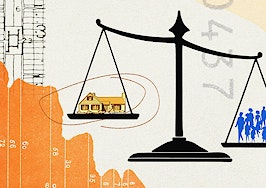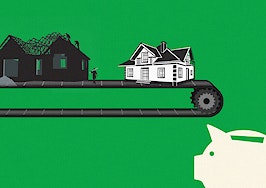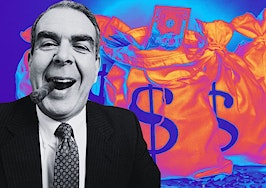This report is available exclusively to subscribers of Inman Intel, a data and research arm of Inman offering deep insights and market intelligence on the business of residential real estate and proptech. Subscribe today.
It’s not high home prices. It’s not a lack of buyer demand. And it’s not a distressed-property crisis like in 2007.
The main culprit behind today’s depressed home market is the so-called “rate lock-in” effect, where the rate on a typical homeowner’s mortgage is so much lower than the rate they could get on their next loan that it makes little sense for them to list their current home — or purchase a new one.
But when will this let up?
How long it will take for the market to claw out of this downturn in home-sale activity cannot be known. But using more than four decades of data from Freddie Mac, the U.S. Bureau of Economic Analysis and the National Association of Realtors, Intel analyzed the so-called “rate lock-in” effect and how it has impacted home sales in the past.
What Intel found is that today’s mortgage-rate environment is so extreme that you’d need to reach back to the inflationary period of the 1970s and 1980s to find a comparable moment for the housing market. And back then, it took more than a half-decade for home sales to recover from the fallout.
Real estate tech strategist Mike DelPrete shies away from predicting how long it will take for sales to recover. But he believes the first step toward normalization is the Federal Reserve backing off of its current inflation-fighting, rate-hiking course.
And so far that’s not in the Fed’s immediate plans.
“For us to ‘get back to normal,’ interest rates need to come down,” DelPrete told Intel. “And last I checked, the Fed was still raising them and was signaling future raises. So a ‘fast recovery’ is kind of incomprehensible to me. What would that possibly mean or look like, other than wishful thinking?”
Here’s what Intel learned from four decades of real estate data.
Out of balance
Many aspects of the coronavirus-pandemic home market seem unprecedented. But homeowners backing off the market amid rapidly rising mortgage rates? That was not one of them.
Intel’s review of data from the Bureau of Economic Analysis and Freddie Mac reveals this type of gap between rates on new loans and existing loans isn’t unique to this moment. It is, however, extremely rare, as seen in the chart below.
Where the blue line is above the white line, holding on to an existing mortgage would have been more attractive than purchasing a different home at the rates of the time.

Chart by Daniel Houston
It’s apparent that there’s been nothing like the present gap dating back through the 1990s. Even the 2007 housing bust that led to the Great Recession was caused primarily by other factors, rather than a huge mortgage-rate disparity.
The one other towering exception of the last half-century? That would be the inflationary period of the late 1970s and early 1980s when the Fed — like today — was raising interest rates aggressively in an effort to fight consumer-price inflation.
We can see from the blue line in the chart above that mortgage rates in the late 1970s and early 1980s followed the Fed’s lead. And while it did push up the rates on outstanding loans over time, this step occurred more gradually. As a result, it wasn’t until rates came back down that the market was able to rebalance.
At first glance, the chart above suggests that the rate gap between new loans and outstanding loans was wider in the 1980s than it is today. But that may be visually misleading.
If we look instead at the same gap as a percentage of the outstanding-loan rate of each period, we see that today’s mortgage rates may have an even more pronounced effect on homebuyers than they did back then.

Chart by Daniel Houston
In the fall of 2022, mortgage rates flirted briefly with double the rate held by a typical homeowner — a ratio that the market never approached even in the 1980s, when most rates were already in the double digits to begin with.
Today, home prices are near all-time highs. A doubling of mortgage rates therefore has large implications for many homeowners who might otherwise be inclined to move.
It’s already depressing home sales. And it’s unclear whether the market has hit bottom yet.
Reliving history
It’s not just the mortgage rates that bear a striking similarity to the previous inflationary period.
The number of existing single-family home sales is following a remarkably similar pattern today as it did in the 1970s and 1980s on a seasonally adjusted basis, according to data from the National Association of Realtors reviewed by Intel.
To compare the periods, Intel used the following reference point: The first month when mortgage rates on new loans exceeded 50 percent above the rate on the typical existing loan. In the last inflationary period, that month was January 1980. More recently that date was May 2022.
Looking at the three years leading up to those reference points and the year that followed, the two periods followed an eerily similar path — with the notable exception of the early 2020 plummet in home sales as much of society locked down and fears of the coronavirus spread.

Chart by Daniel Houston
Just because the two lines above have tracked closely with each other so far does not mean they will continue to do so going forward. Many factors affect home sales and mortgage rates, and the Fed could change direction as its board continues to digest the latest slowing inflation numbers.
But what is clear is that during the only other recent inflationary period in which the Fed raised interest rates in such a disruptive way, it took more than a half-decade for existing single-family sales to recover fully.
And at least until markets see a change in Fed policy, DelPrete expects housing activity to remain depressed.
“It seems like we are where we are,” DelPrete told Intel. “We have more certainty around the markets and interest rates and what the Fed is doing. And this is kind of where we’re at. So get used to it.”
Ongoing headwinds
How the coming months will play out is unclear. But Intel identified two factors that could signal when a market turnaround might finally start picking up steam.
On any given month in the past four decades, the size of the gap between buyer mortgage rates and homeowner mortgage rates not only explains where the market has ended up but a small share — 5 percent — of how existing-home sales will change over the ensuing six months, Intel found.
An even more telling predictor of future sales changes? How much that mortgage-rate gap has shifted over the previous six months. This explains 12 percent of the variance in future sales over the six months that follow, Intel’s analysis shows.
To be clear, this means the vast majority of what drives home prices in a given six-month window is tied to other events, including things that can’t be known to observers before that six-month window begins.
But the rate gap and the speed with which that gap has changed both clearly carry some statistical weight.
One thing this means is that existing-home sales can recover in an environment where mortgage rates are far higher than the rates on existing loans. That gap just has to start closing, enticing homeowners on the margins to finally list their homes as they see the rate nearer to what they have on their homes.
The market is not at that point yet.
In this case, both of these factors are working against a meaningful home-sales recovery.
Not only are today’s mortgage rates 85 percent higher than the rate on the typical homeowner’s loan, but that gap has actually expanded by 44 basis points over the past six months. The runup in mortgage rates since March has ensured momentum remains in the wrong direction from the point of view of real estate businesses that rely on transaction commissions.
And that’s an environment that could place added downward pressure on home sales in the months to come.

















